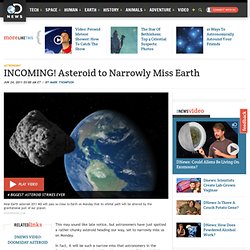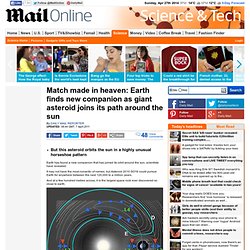

INCOMING! Asteroid to Narrowly Miss Earth on Monday. This may sound like late notice, but astronomers have just spotted a rather chunky asteroid heading our way, set to narrowly miss us on Monday.

In fact, it will be such a narrow miss that astronomers in the Southern Hemisphere should be able to spot the flyby with fairly modest telescopes. ANIMATIONS: Watch 2011 MD zip past the Earth in this series of animations. Coincidentally, I was watching yet another re-run of Armageddon the other night when the heroic Bruce Willis and his motley crew of oil drillers-turned-astronauts saved Earth from certain asteroid doom. On arrival at the asteroid, and having sacrificed many of the team, Willis et al. succeeded in dropping a typical Hollywood-style uber-bomb into the depths of the incoming asteroid and blew it to bits, giving everyone on Earth a glitzy meteor shower. I'm not so sure it will be really that easy to destroy an incoming asteroid (see my previous Discovery News article "How do we dodge the next incoming asteroid? ") Earth joined by giant asteroid around the sun in unusual horseshoe pattern.
By Daily Mail Reporter Updated: 08:44 GMT, 7 April 2011 But this asteroid orbits the sun in a highly unusual horseshoe pattern Earth has found a new companion that has joined its orbit around the sun, scientists have revealed.

It may not have the most romantic of names, but Asteroid 2010 SO16 could pursue Earth for anywhere between the next 120,000 to a million years. And at a few hundred metres across, it is the largest space rock ever discovered so close to earth. Very unusual: Rather than follow its new friend all the way round, SO16 orbits the sun in a horseshoe shape, playing a constant game of catch up with Earth But there is something unusual about SO16, say Apostolos Christou and David Asher who discovered the giant floating rock last September at the Armagh Observatory in Northern Ireland.
Rather than follow its new friend all the way round, SO16 orbits the sun in a horseshoe shape, playing a constant game of catch up with Earth, they say. Near-Earth Object Program. Very Early Warning: 1-in-1,000 Chance of Asteroid Impact in 2182. This isn’t an urgent call to arms, but it’s certainly a future date to consider.

In the year 2182 — 172 years time — there’s the possibility that we might be hit by an asteroid with potential to cause some significant global turmoil. This long-distance forecast could help mankind determine whether asteroid deflection techniques are warranted, especially when given nearly two centuries of lead time. SLIDE SHOW: Top 10 Ways to Stop an Asteroid The not-so-romantically named (101955) 1999 RQ36 — discovered in 1999 — measures approximately 510 meters in diameter and is classified as an Apollo asteroid.
Apollo asteroids pose a threat to our planet as they routinely cross Earth’s orbit. With a one-in-a-thousand chance of 1999 RQ36 hitting Earth — with half of this probability indicating a 2182 impact — the threat might not sound too acute. But compare this with the panic that ensued with the discovery of 99942 Apophis in 2004. Doppler imagery of 1999 RQ36 by NASA’s Goldstone Radar. Two Small Asteroids to Pass Close by Earth on September 8, 2010. Two Small Asteroids to Pass Close by Earth on September 8, 2010 NASA/JPL Near-Earth Object Program Office September 7, 2010 Two asteroids, several meters in diameter and in unrelated orbits, will pass within the Moon's distance of Earth on Wednesday, September 8th.

The Catalina Sky Survey near Tucson Arizona discovered both objects on the morning of September 5 during their routine monitoring of the skies. The Minor Planet Center in Cambridge Massachusetts first received the observations Sunday morning, determined preliminary orbits and concluded that both objects would pass within the distance of the Moon about three days after their discovery. Near Earth asteroid 2010 RX30 is estimated to be 10 to 20 meters in size and will pass within 0.6 lunar distances of Earth (about 248,000 km) at 9:51 Greenwich standard time (5:51 am EDT) Wednesday.